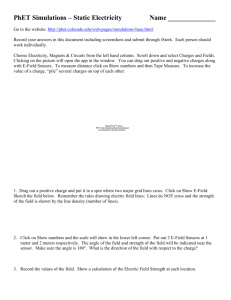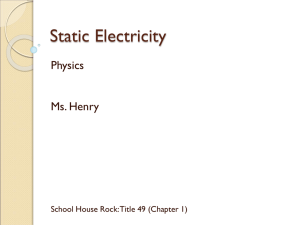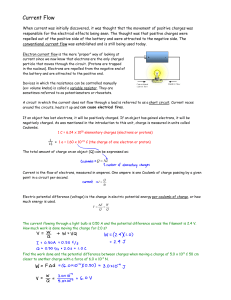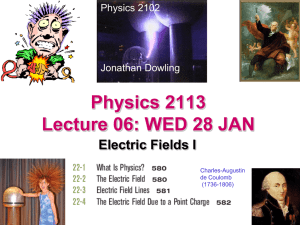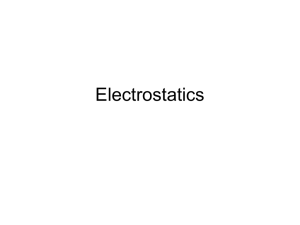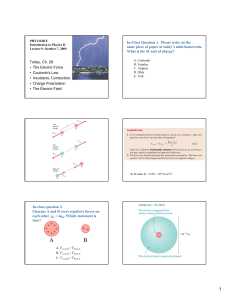Charges and Electric Fields - University of Colorado Boulder
advertisement
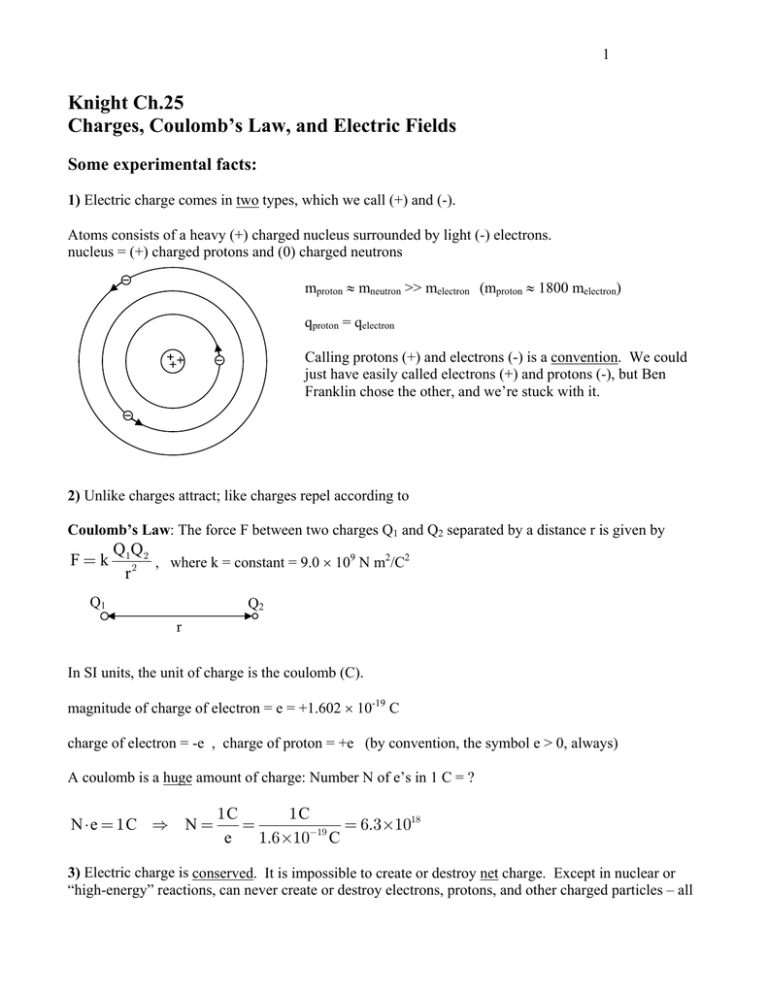
1 Knight Ch.25 Charges, Coulomb’s Law, and Electric Fields Some experimental facts: 1) Electric charge comes in two types, which we call (+) and (-). Atoms consists of a heavy (+) charged nucleus surrounded by light (-) electrons. nucleus = (+) charged protons and (0) charged neutrons mproton ≈ mneutron >> melectron (mproton ≈ 1800 melectron) qproton = qelectron Calling protons (+) and electrons (-) is a convention. We could just have easily called electrons (+) and protons (-), but Ben Franklin chose the other, and we’re stuck with it. 2) Unlike charges attract; like charges repel according to Coulomb’s Law: The force F between two charges Q1 and Q2 separated by a distance r is given by F=k Q1 Q 2 , where k = constant = 9.0 × 109 N m2/C2 2 r Q1 Q2 r In SI units, the unit of charge is the coulomb (C). magnitude of charge of electron = e = +1.602 × 10-19 C charge of electron = -e , charge of proton = +e (by convention, the symbol e > 0, always) A coulomb is a huge amount of charge: Number N of e’s in 1 C = ? N ⋅e = 1C ⇒ N = 1C 1C = = 6.3×1018 −19 e 1.6×10 C 3) Electric charge is conserved. It is impossible to create or destroy net charge. Except in nuclear or “high-energy” reactions, can never create or destroy electrons, protons, and other charged particles – all 2 we can do is move them around. In high energy reactions, we can create charged particles from energy (energy = mc2), but particles are always created or destroyed in pairs (+1 and -1) so that net charge is conserved. Aside: As far as we know, only 4 things in the universe are conserved: (1) Energy (2) Linear momentum (p = mv) (3) Angular momentum (spin = L = Iω) (4) Charge [Not quite true: in high energy physics, there may be other quantities, like “baryon number” that are conserved.] 4) e is the fundamental unit of charge. You never find a free particle in nature with charge = fraction of e, always find charge = e or integer multiple of e. 1) thru 4) are experimental facts. Why are they true? Why are there 2 kinds of charge, not 3? Why e = 1.6 × 10-19 C, not 4.2 × 10-19 C? Why is charge conserved? We don’t know! And to some extent, physicists don’t care. It is the primary goal of physics to describe how nature behaves; a secondary goal is to explain why it behaves that way. (Many theorists are looking to explain why, but no luck yet…) Notice that Coulomb’s law is similar to Newton’s Universal Law of Gravitation: Gm1m 2 , r2 Fgrav = Fcoul = kq1q 2 r2 Similar, except that there are two kinds of charge, but only one kind (sign) of mass. Gravity is always attractive, but electrical force can be attractive or repulsive. Recall that force is a vector – a mathematical object that has a size (magnitude) and a direction. Forces add like vectors, not numbers. Example: Net force on electron due to two nearby protons, each distance r away, 90o apart. r -e 90o r Net force = Fnet = F1 + F2 F1 q1 = +e In this particular case, F1 = F2 = F = F2 q2 = +e Fnet = 2 F Fnet = Recall: 2 k e2 r2 (not 2F) k e2 r2 . 3 F √2 1 F Fnet = (2)1/2 F 1 Superposition Principle: the net force on a charge due to other nearby charges is the vector sum of the individual forces: Fnet = F1 + F2 + F3 + ... , where F1 = net force due to charge 1, etc. Now, a new concept: the Electric field. Surrounding every charge (or group of charges) is an electric field E (it is a vector thing) Definition: The electric field E at a point in empty space is a vector quantity which can be measured by the following procedure: place a small test charge q at that point, measure the force F on q due to other charges. The electric field is E= Fon q q E-field at a point is the force per charge on a test charge placed at that point. Note! The E-field exists even if there is no test charge present to measure it. Similarly, a gravitational field surrounds the earth, even if there is no “test mass” nearby to measure the pull of earth’s gravity: F mg gravitational field ≡ on m = = g, m m F 1 GMm GM = = 2 m m r2 r (M = earth mass, m = test mass, r = distance from m to Earth’s center) magnitude g = What is the E-field around a point charge Q? (Q = “source charge” = “source” of E-field, q = “test charge” or “probe charge”) source charge Q r test charge +q Fon q E= kQ F 1 kQq ˆr = 2 ˆr = 2 q q r r 4 ( r̂ is unit vector pointing away from Q, gives direction of E . r̂ has no units.) E-field around a positive charge points always from the charge, and decreases in magnitude with 1 distance r as E ∝ 2 . r What if the test charge q in E = Fon q q is negative? E-field still points away from positive source charge Q, since both F changes direction and q switches sign. E-field points away from positive charges, points toward negative charges. Two different views of interaction between charges: “Action at a distance” vs. “Fields” “Action at a distance” : Coulomb’s Law suggests that two charges exert a force on each other through empty space, instantaneously. But Coulomb’s law is only valid for stationary charges. If charge 1 moves, it takes some time for charge 2 to sense the change. The more modern “field-view” is: Charge 1 creates an E-field around it. Charge 2 feels that field. If Charge 1 moves, it takes some time for the surrounding E-field to change, so takes some time for charge 2 to react. 5 The total E-field due to a collection of charges is the vector sum of the E-fields due to the individual charges: k Qi E total = E1 + E 2 + E 3 + … = ∑ E i = ∑ 2 ˆri ri i i Why? Superposition Principle says that if we place a small test charge q near other charges Q1, Q2, Q3,… , then the net force on q is Ftotal F1 F2 Ftotal = F1 + F2 + … ⇒ = + + … ⇒ E total = E1 + E 2 + … q q q Metals vs. Insulators Most materials can be classified as metal or insulator (insulator also called dielectric) Metals (Cu, Al, Au, Ag, Fe…) conduct electricity. In metals, some of the electrons (conduction electrons) can move freely thru the metal. If there is an E-field, the conduction electrons move in response to the force F = q E and so a flow of charge, or current, occurs. The inner core electrons are bound strongly to their nuclei, but the outer core, conduction electrons are unbound, free to move among the nuclei. Metals usually have 1 or 2 conduction electrons per atom. (In chemist talk: “valence = 2” means “2 conduction electrons per atom”.) Insulators (plastic, wood, ceramic, sulfur) do not conduct electricity. In insulators, all the electrons are strongly attached to their nuclei, and do not move (much), even if there is an E-field exerting a force on them. Metals are shiny, insulators are dull. The appearance is a consequence of the mobility of the electrons. Insulators can have an induced charge due to induced dipole moments. All atoms, some molecules, have no permanent dipole moment, but acquire an induced moment when an external E-field is applied. neutral atom E=0 polarized atom in external field E Some molecules have a permanent dipole moment, like H2O. In an external E-field, the moments align. 6 = H2O molecule = dipole moment moments align in E-field Induced charge always produces an attractive force. Note the example above. The line of positive charges induces charge on the surface of the molecular material. The opposite charge is always closest, resulting in attraction.

